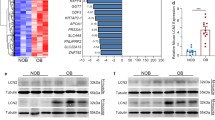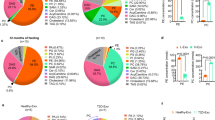Abstract
Background
Obesity is associated with risk of adenocarcinoma in the proximal stomach. We aimed to identify the links between dietary fat and gastric premalignant lesions.
Methods
C57BL/6 mice were fed high fat diet (HFD), and gastric mucosa was histologically analysed. Morphological changes were also analysed using an electron microscope. Transcriptome analysis of purified parietal cells was performed, and non-parietal gastric corpus epithelial cells were subjected to single-cell gene-expression profiling. Composition of gastric contents of HFD-fed mice was compared with that of the HFD itself. Lipotoxicity of free fatty acids (FFA) was examined in primary culture and organoid culture of mouse gastric epithelial cells in vitro, as well as in vivo, feeding FFA-rich diets.
Results
During ~8–20 weeks of HFD feeding, the parietal cells of the stomach displayed mitochondrial damage, and a total of 23% of the mice developed macroscopically distinct metaplastic lesions in the gastric corpus mucosa. Transcriptome analysis of parietal cells indicated that feeding HFD enhanced pathways related to cell death. Histological analysis and gene-expression profiling indicated that the lesions were similar to previously reported precancerous lesions identified as spasmolytic polypeptide-expressing metaplasia. FFAs, including linoleic acid with refluxed bile acids were detected in the stomachs of the HFD-fed mice. In vitro, FFAs impaired mitochondrial function and decreased the viability of parietal cells. In vivo, linoleic acid-rich diet, but not stearic acid-rich diet induced parietal-cell loss and metaplastic changes in mice.
Conclusions
Dietary lipids induce parietal-cell damage and may lead to the development of precancerous metaplasia.






Similar content being viewed by others
Abbreviations
- DCA:
-
Deoxycholic acid
- EM:
-
Electron microscopy
- FFA:
-
Free fatty acids
- HBSS:
-
Hank’s balanced salt solution
- HFD:
-
High fat diet
- HK-ATPase:
-
H+/K+-ATPase
- LD:
-
Lipid droplet
- SPEM:
-
Spasmolytic polypeptide-expressing metaplasia
- TFF2:
-
Trefoil factor family 2
- RT-PCR:
-
Reverse-transcription PCR
- TG:
-
Triacylglycerides
- TMRM:
-
Tetramethylrhodamine methyl ester
- WHL:
-
White hyperplastic lesion
References
Ogden CL, Yanovski SZ, Carroll MD, et al. The epidemiology of obesity. Gastroenterology. 2007;132(6):2087–102.
Aleman JO, Eusebi LH, Ricciardiello L, et al. Mechanisms of obesity-induced gastrointestinal neoplasia. Gastroenterology. 2014;146(2):357–73.
Chow WH, Blot WJ, Vaughan TL, et al. Body mass index and risk of adenocarcinomas of the esophagus and gastric cardia. J Natl Cancer Inst. 1998;90(2):150–5.
Merry AH, Schouten LJ, Goldbohm RA, et al. Body mass index, height and risk of adenocarcinoma of the oesophagus and gastric cardia: a prospective cohort study. Gut. 2007;56(11):1503–11.
Olefson S, Moss SF. Obesity and related risk factors in gastric cardia adenocarcinoma. Gastric Cancer. 2015;18(1):23–32.
Steffen A, Huerta JM, Weiderpass E, et al. General and abdominal obesity and risk of esophageal and gastric adenocarcinoma in the European Prospective Investigation into Cancer and Nutrition. Int J Cancer. 2015;37:646–57.
Abnet CC, Freedman ND, Hollenbeck AR, et al. A prospective study of BMI and risk of oesophageal and gastric adenocarcinoma. Eur J Cancer. 2008;44(3):465–71.
Schulz MD, Atay C, Heringer J, et al. High-fat-diet-mediated dysbiosis promotes intestinal carcinogenesis independently of obesity. Nature. 2014;514(7523):508–12.
Turnbaugh PJ, Backhed F, Fulton L, et al. Diet-induced obesity is linked to marked but reversible alterations in the mouse distal gut microbiome. Cell Host Microbe. 2008;3(4):213–23.
Yoshimoto S, Loo TM, Atarashi K, et al. Obesity-induced gut microbial metabolite promotes liver cancer through senescence secretome. Nature. 2013;499(7456):97–101.
Chak A, Falk G, Grady WM, et al. Assessment of familiality, obesity, and other risk factors for early age of cancer diagnosis in adenocarcinomas of the esophagus and gastroesophageal junction. Am J Gastroenterol. 2009;104(8):1913–21.
de Jonge PJ, van Blankenstein M, Grady WM, et al. Barrett’s oesophagus: epidemiology, cancer risk and implications for management. Gut. 2014;63(1):191–202.
Uemura N, Okamoto S, Yamamoto S, et al. Helicobacter pylori infection and the development of gastric cancer. N Engl J Med. 2001;345(11):784–9.
Quante M, Abrams JA, Lee Y, et al. Barrett esophagus: what a mouse model can teach us about human disease. Cell Cycle. 2012;11(23):4328–38.
Tatematsu M, Tsukamoto T, Inada K. Stem cells and gastric cancer: role of gastric and intestinal mixed intestinal metaplasia. Cancer Sci. 2003;94(2):135–41.
Goldenring JR, Nam KT. Oxyntic atrophy, metaplasia, and gastric cancer. Prog Mol Biol Transl Sci. 2010;96:117–31.
Goldenring JR, Nomura S. Differentiation of the gastric mucosa III. Animal models of oxyntic atrophy and metaplasia. Am J Physiol Gastrointest Liver Physiol. 2006;291(6):999–1004.
Nomura S, Baxter T, Yamaguchi H, et al. Spasmolytic polypeptide expressing metaplasia to preneoplasia in H. felis-infected mice. Gastroenterology. 2004;127(2):582–94.
Nomura S, Yamaguchi H, Ogawa M, et al. Alterations in gastric mucosal lineages induced by acute oxyntic atrophy in wild-type and gastrin-deficient mice. Am J Physiol Gastrointest Liver Physiol. 2005;288(2):G362–75.
Oshima M, Oshima H, Matsunaga A, et al. Hyperplastic gastric tumors with spasmolytic polypeptide-expressing metaplasia caused by tumor necrosis factor-alpha-dependent inflammation in cyclooxygenase-2/microsomal prostaglandin E synthase-1 transgenic mice. Cancer Res. 2005;65(20):9147–51.
Schmidt PH, Lee JR, Joshi V, et al. Identification of a metaplastic cell lineage associated with human gastric adenocarcinoma. Lab Invest. 1999;79(6):639–46.
Wang TC, Goldenring JR, Dangler C, et al. Mice lacking secretory phospholipase A2 show altered apoptosis and differentiation with Helicobacter felis infection. Gastroenterology. 1998;114(4):675–89.
Schumacher MA, Feng R, Aihara E, et al. Helicobacter pylori-induced Sonic Hedgehog expression is regulated by NFkappaB pathway activation: the use of a novel in vitro model to study epithelial response to infection. Helicobacter. 2015;20(1):19–28.
Fujimoto T, Ohsaki Y, Suzuki M, et al. Imaging lipid droplets by electron microscopy. Methods Cell Biol. 2013;116:227–51.
Quante M, Bhagat G, Abrams JA, et al. Bile acid and inflammation activate gastric cardia stem cells in a mouse model of Barrett-like metaplasia. Cancer Cell. 2012;21(1):36–51.
Backhed F, Manchester JK, Semenkovich CF, et al. Mechanisms underlying the resistance to diet-induced obesity in germ-free mice. Proc Natl Acad Sci USA. 2007;104(3):979–84.
Tilg H, Kaser A. Gut microbiome, obesity, and metabolic dysfunction. J Clin Invest. 2011;121(6):2126–32.
Hagio M, Matsumoto M, Fukushima M, et al. Improved analysis of bile acids in tissues and intestinal contents of rats using LC/ESI-MS. J Lipid Res. 2009;50(1):173–80.
Ikeda K, Oike Y, Shimizu T, et al. Global analysis of triacylglycerols including oxidized molecular species by reverse-phase high resolution LC/ESI-QTOF MS/MS. J Chromatogr B Analyt Technol Biomed Life Sci. 2009;877(25):2639–47.
Glinghammar B, Inoue H, Rafter JJ. Deoxycholic acid causes DNA damage in colonic cells with subsequent induction of caspases, COX-2 promoter activity and the transcription factors NF-kB and AP-1. Carcinogenesis. 2002;23(5):839–45.
Uchida K. 4-Hydroxy-2-nonenal: a product and mediator of oxidative stress. Progress Lipid Res. 2003;42(4):318–43.
Bailey AP, Koster G, Guillermier C, et al. Antioxidant Role for Lipid Droplets in a Stem Cell Niche of Drosophila. Cell. 2015;163(2):340–53.
Naito Y, Uchiyama K, Kuroda M, et al. Role of pancreatic trypsin in chronic esophagitis induced by gastroduodenal reflux in rats. J Gastroenterol. 2006;41(3):198–208.
Farese RV Jr, Walther TC. Lipid droplets finally get a little R-E-S-P-E-C-T. Cell. 2009;139(5):855–60.
Islami F, Kamangar F. Helicobacter pylori and esophageal cancer risk: a meta-analysis. Cancer Prev Res. 2008;1(5):329–38.
Kamangar F, Dawsey SM, Blaser MJ, et al. Opposing risks of gastric cardia and noncardia gastric adenocarcinomas associated with Helicobacter pylori seropositivity. J Natl Cancer Inst. 2006;98(20):1445–52.
Acknowledgements
We thank Prof. N. Mizushima for valuable advises for our experiments. We thank Ms. Y. Nozaki and Ms. M. Inokuchi for their technical assistance. This work was supported partly by grants and contracts from the program Grants-in-Aid for Scientific Research (B), 5H04503 and for TD and Grants-in-Aid for Scientific Research (C), 25460965 for YIK) from the Ministry of Education, Cultures, Sports, Science, and Technology; the Japan Science and Technology Agency; a grant from the National Centre for Global Health and Medicine (22-205, 25-104 for TD, 23-101, 26-110, 26-117, and 27-1406 for YIK), Ministry of Health, Labour, and Welfare; and RIKEN RCAI (TD).
Author contributions
YH, TS, TH, MT-N, CO, TI, SF, TE and YIK, acquisition of data; YIK and TD, study concept and design; YH, TS, TH, KY, KH, SF, TD, and YIK, analysis and interpretation of data; YH, TS, SF, TD, and YIK, drafting of the manuscript; YH, SF, TD and YIK, obtaining funding.
Author information
Authors and Affiliations
Corresponding authors
Ethics declarations
Conflict of interest
The authors declare that they have no conflict of interest.
Additional information
Accession # for transcriptome data: GSE87594.
Electronic supplementary material
Below is the link to the electronic supplementary material. More Materials and Methods are described in the Electronic Supplementary Material and Supplementary Table 2.
Rights and permissions
About this article
Cite this article
Hirata, Y., Sezaki, T., Tamura-Nakano, M. et al. Fatty acids in a high-fat diet potentially induce gastric parietal-cell damage and metaplasia in mice. J Gastroenterol 52, 889–903 (2017). https://doi.org/10.1007/s00535-016-1291-0
Received:
Accepted:
Published:
Issue Date:
DOI: https://doi.org/10.1007/s00535-016-1291-0




